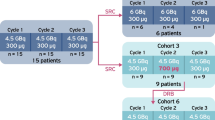Abstract
Lanreotide (BIM 32014), a somatulin analogue, was found to be as effective as castration in a rat prostate tumor model. Therapeutic benefit was also demonstrated in the hormone-resistant phase of this tumor model. The activity of lanreotide may be due to a reduction in the levels of growth factors such as insulin growth factor 1 (IGF1). A total of 30 patients with hormone-refractory prostate cancer were treated with a slow-release formulation of lanreotide. The mean age was 71 years. Patients were treated with one intramuscular injection of 30mg BIM 23014 once a week and were followed for prostage-specific antigen (PSA) level evolution until disease progression or WHO grade 3 or 4 toxicity and for survival. The patients were treated for a mean duration of 12 weeks (range, 2–60 weeks). The performance status and bone pain were improved in 40% and 35% of patients, respectively. In all, 20% of the patients had a decrease of ≥50% in PSA levels and 16% showed a stabilization. The biological response was correlated with clinical improvement. The 1-year global survival rate was 72%, with the rate being 89% in the group of patients who were responders on PSA plasma level and 64% in patients with progressive disease. The response duration ranged from 16 to 60 weeks. Toxicity was minor, with transient grade I digestive side effects being noted in a few patients. Lanreotide given at 30 mg once a week to patients with metastatic hormone-refractory prostate cancer was well tolerated. The response rate was higher than that reported in recent published series. Higher doses of lanreotide should be evaluated.
Similar content being viewed by others
References
Bauer W, Briner V, Doefner W (1982) SMS201-995: a very potent and selective octapeptide analog of Somatostatin with prolonged action. Life Sci 31:1133–1140
Bogden AE, Taylor JE, Moreau JP, Coy DH (1990) Treatment of R-3327H prostate tumors with a Somatostatin analogue (Somatuline) as a adjuvant therapy following surgical castration. Cancer Res 50:2646–2650
Brazeau P. Vale W (1973) Hypothalamic polypeptide that inhibits the secretion of immunoreactive pituitary growth hormone. Science 179:77–79
Dupond A, Boucher H, Cusan L (1990) Octreotide and Bromocriptine in patients with stage D2 prostate cancer who relapsed during treatment with flutamide and castration. Eur J Cancer 26:770–771
Fassler JE, Hughes JH, Titterington L (1988) Somatostatin analog: an inhibitor of angiogenesis? Clin Res 36:869
Kelly WK, Scher H, Mazumdar M, Vlamis V, Schartz M, De Fossa S (1993) Prostate-specific antigen as a measure of disease outcome in metastatic hormone refractory prostate cancer. J Clin Oncol 11:607–615
Klein LA (1968) Prostatic carcinoma. N. Engl J Med 300:824–833
Lamberts SN, Koper JW, Reubi JC (1987) Potential role of somatostatin analogues in the treatment of cancer. Eur J Clin Invest 17:281–287
Meyers F, Soares S, De Verewhite R (1991) A phase II study of Octreotide in metastatic carcinome of the prostate (abstract 566). Proc Am Soc Clin Oncol 10:176
Moreau JP, De Feundis FV (1987) Minireview. Pharmacological studies of Somatostatin and Somatostatin analogues: therapeutic advances and perspectives. Life Sci 40:419–437
Murphy GP (1987) To what degree is chemotherapy useful in the treatment of prostatic cancer? In: Murphy G, Koury S (eds) Prostate cancer, part B. Allan Liss, New York, p. 247
Parmar H, Bogden A, Mollard M, De Rouge B, Phillips RH, Lightman S (1989) Somatostatin and Somatostatin analogues in oncology. Cancer Treat Rev 16:95–115
Parmar H, Charlton A, Phillips RH, Edwards L, Bejot JL, Thomas F, Lightman SL (1992) Therapeutic response to Somatostatin analogue BIM 23014 in metastatic prostatic cancer. Clin Exp Metastasis 10:3–11
Penn RD, Paice JA, Kroin JS (1990) Intrathecal Octreotide for cancer pain. Lancet 335:7384
Sasaki A, Yoshinaga K (1989) Immunoreactive Somatostatin in male reproductive system in humans. J Clin Endocrinol Metab 68:996–998
Schally AV (1988) Oncological applications of Somatostatin analogues. Cancer Res 48:6977–6985
Sporn HB, Roberts AB (1985) Autocrine growth factors and cancer. Nature 313:745–747
Stolfi R, Parisi AM, Natoli C, Jaobelli S (1990) Advanced breast cancer: response to Somatostatin. Anticancer Res 10:203–204
Author information
Authors and Affiliations
Rights and permissions
About this article
Cite this article
Maulard, C., Richaud, P., Droz, J.P. et al. Phase I–II study of the somatostatin analogue lanreotide in hormone-refractory prostate cancer. Cancer Chemother. Pharmacol. 36, 259–262 (1995). https://doi.org/10.1007/BF00685857
Received:
Accepted:
Issue Date:
DOI: https://doi.org/10.1007/BF00685857




